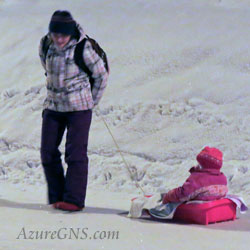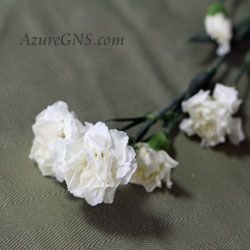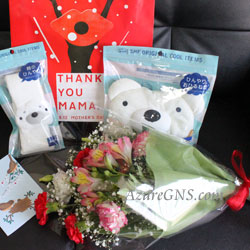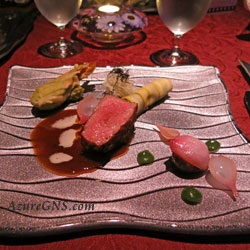(5月の第2日曜日)
Haha-no-hi;
Mother’s Day
(the Second Sunday of May)
●母の日 Haha-no-hi; Mother’s Day
●母 mother
●実母 biological mother; one’s own real mother
(ownは義母ではない、realは継母ではないことを表す。)
●継母 stepmother
●姑 mother-in-law
●感謝 gratitude; thanks; appreciation
●敬愛 piety; love; reverence
●カーネーション carnation
●プレゼント gift; present
●家事 housework; housekeeping; domestic duties
●料理 cooking
●掃除 cleaning; (大掃除)cleanup; (一掃)sweeping
●選択 washing; wash
●育児 child care; nurse
●主婦 housewife; 【米Am.】housemaker; the lady of the house
◆母の日は5月の第2日曜日です。
Mother’s Day is celebrated in honor of mothers on the second Sunday of May.
◆母の日の歴史は長く、その起源は古代ギリシャまでさかのぼります。
The history of Mother’s Day is very long, and its origin dates back to Ancient Greece.
◆アメリカの母の日は、ウエストバージニア州のアンナ・ジャービスさんによって提唱されたと言われています。
It is said that Anna Jarvis in West Virginia advocated Mother’s Day in the USA.
◆1907年、彼女は母親の命日に追悼式を開きました。
In 1907, she held a memorial ceremony for her mother on the anniversary of her mother’s death.
◆彼女のおかあさんが好きだった白いカーネーションを捧げ、式の参加者にも一輪ずつ手渡しました。
To her mother’s memory, she offered white carnations, which her mother had liked, and also handed a white carnation to each in attendance.
◆その後間もなく、母親が生きている人は赤いカーネーションを胸につけるようになりました。
Shortly afterwards, people whose mothers were alive started wearing red carnations on their chest.
◆母親が亡くなっている人は白いカーネーションをつけるようになりました。
People whose mothers had passed away began to wear white carnations.
◆カーネーションはキリスト教では神聖な花とされています。
Carnations are regarded as holy flowers in Christianity.
◆1914年、ウィルソン大統領によって母の日は正式に祝日と制定され、後にこの習慣はアメリカより日本に伝わりました。
In 1914 President Wilson declared Mother’s Day, a national holiday, and later this custom spread to Japan from the USA.
◆日本で一般に広まったのは1950年(昭和25年)頃で、日本人が母の日にカードを添えて、カーネーションやプレゼントを母親へ贈るようになりました。
It became a popular practice in Japan, around 1950 (Showa 25th yr), and Japanese people started to present carnations and gifts with cards to their mothers on Mother’s Day.
◆母の日が近づくと花屋にはカーネーションの切り花、鉢植え、アレンジが並びます。
As Mother’s Day draws near, flower shops are full of carnations: cut ones, potted ones and arranged ones.
◆少し前までは赤いカーネーションと白いかすみ草の花束が母の日の定番でしたが、最近はオレンジ、黄、黄緑、紫そして白と赤の混ざったものもあります。
Not long ago, the standard bouquet for Mother’s Day consisted of only red carnations and white gypsophilas (baby’s breath) but now color variations have been increasing such as orange, yellow, yellowish green, purple and a mixture of white and red.
◆お店では母の日のプレゼント用の多種多様な商品が売り出されます。
There are a wide variety of gifts for Mother’s Day at shops.
◆遠くに住む母親のために、宅配サービスや、ネット販売も充実しています。
Delivery services and online sales are useful to send gifts to mothers who live far away.
◆食事に招待することも多いです。
They often invite their mothers to dinner.
◆ただ側にいて、一緒にゆっくり母の日を過ごす人もいます。
Some just spend Mother’s Day relaxing with their mothers.
◆1日だけでもゆっくりしてもらうために、家事を代わりにしてあげる人もいます。
Others do housework on their mother’s behalf, so that she can enjoy a relaxing day, at least on Mother’s Day.
◆子供達は幼稚園や小学校でおかあさんの似顔絵を描いたり、感謝の気持ちを表す作文を書いたりすることがあります。
Children draw their mothers’ portraits at preschools and elementary schools, and some children write compositions in order to thank their mothers.
◆お母さん達はこのような手作りのプレゼントをとても喜びます。
Mothers love these homemade presents very much.
◆母親への敬愛と感謝の気持ちは世界共通であり、現在世界中の多くの国で母の日があります。
As piety and gratitude for mothers are universal feelings, nowadays many countries around the world celebrate Mother’s Day.
(より詳しい情報は「我が家の母の日」をご覧下さい。)
(Please see “My Mother’s Day Experience” for further information.)
Copyright (C) Azure Global Network Services. All Rights Reserved.









